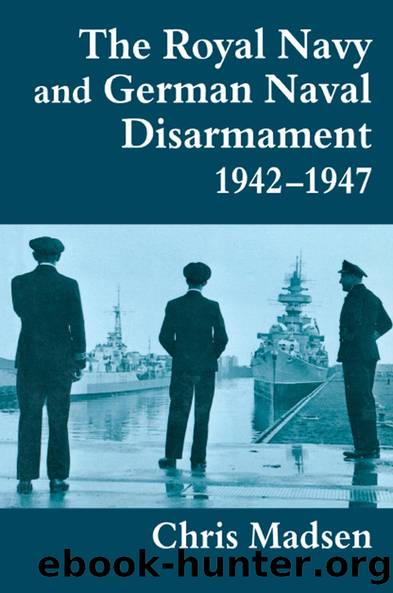The Royal Navy and German Naval Disarmament 1942-1947 by Chris Madsen

Author:Chris Madsen [Madsen, Chris]
Language: eng
Format: epub
Tags: History, Military, General, Nuclear Warfare, Political Science, Security (National & International), Political Freedom
ISBN: 9781135223656
Google: 7sfhDwAAQBAJ
Publisher: Routledge
Published: 2020-05-05T16:00:00+00:00
The Royal Navy intended to deliver minesweepers to the Soviets with compliant German assistance. Schubert asked whether the Soviets might choose to keep crews, perhaps through coercion or duress.58 The question was certainly perplexing. Besides the moral implications, the GM/SA could not afford further manpower losses. To counter this fear, Levchenko personally guaranteed prompt return of crews after arrival at Soviet-controlled ports.59 Although afforded the opportunity to volunteer for Soviet service, German sailors remained under British control and responsibility.
Transfer of minesweepers to the Soviet Union took place in several stages. The operation, known alternately as âScramâ and âBitumenâ, entailed the sailing of convoys to Travemünde for handover to Soviet naval authorities, and thence to Bornholm or Swinemünde under Soviet escort.60 Since Kiel was the major staging point, Baillie-Grohman and his subordinates handled most matters on the British side. Escort officers received detailed instructions, based on extensive staff planning.61 The Soviets, on the other hand, worked differently. Despite British objections, the Soviet naval staff sent Vice-Admiral Iurii Fedorovich Rall, commander-in-chief of the northern Baltic with his headquarters at Kronstadt, to supervise the Soviet side of the transfers.62 Soviet naval authorities generally preferred improvisation to planning. During the first convoy, Commander Frank Mountifort Beasley, RN, found their methods âmaddening to anyone who liked to have a plan ready to meet certain eventualities.â63 Convoys left when Rall decided to wake up in the morning, sometimes without Soviet escorts, and occasionally in the face of adverse weather. After a particularly severe storm near Bornholm which scattered Convoy No. 22, the Soviets shamefully tried to shift the blame onto British naval authorities.64 At times, cooperation with the Soviets stretched British patience.
Despite attempts at genuine goodwill, minor problems inevitably arose at the points of destination. Technically, the ships were under Soviet control after departure from British-controlled ports. Rear-Admiral P.I. Kolchen, the senior Soviet naval officer at Swinemünde, intervened with the Soviet bureaucracy when officials wanted Royal Navy officers to sign receipts for delivered ships.65 The British feared being held responsible for later defects. In other cases, Soviet sentries allowed German sailors to desert, and blocked the movements of British officers. Faced with British protests, the Soviets regularly introduced alcohol to get their own way. Supplied with a hefty glass of vodka by a Soviet liaison officer, Lieutenant-Commander D.A. Grant jettisoned âsurreptitiously the majority of my portion in a cigarette tin and when Commander Vassiliev was subsequently called away there was the unprecedented spectacle of four British Officers making a concerted dash to the heads to throw away their liquor and substitute water.â66 The British quickly learned the advantages of negotiating with the Soviets in a sober state.
After inspections at Swinemünde, Soviet authorities declared that many transferred minesweepers lacked important equipment. Following a particularly strong protest from Levchenko, Burrough responded that the Soviets had no âright to complain of the slowness of transfer at the same time as the alleged bad state of the craft.â67 Spare parts and fittings to bring the ships up to operational standards were in short supply, even in the British Zone.
Download
This site does not store any files on its server. We only index and link to content provided by other sites. Please contact the content providers to delete copyright contents if any and email us, we'll remove relevant links or contents immediately.
| Biological & Chemical | Conventional |
| Nuclear |
The Radium Girls by Kate Moore(11970)
100 Deadly Skills by Clint Emerson(4879)
Rise and Kill First by Ronen Bergman(4739)
The Templars by Dan Jones(4656)
The Doomsday Machine by Daniel Ellsberg(4449)
The Rape of Nanking by Iris Chang(4165)
Killing England by Bill O'Reilly(3968)
Hitler in Los Angeles by Steven J. Ross(3923)
Stalin by Stephen Kotkin(3918)
12 Strong by Doug Stanton(3526)
Hitler's Monsters by Eric Kurlander(3291)
Blood and Sand by Alex Von Tunzelmann(3164)
The Code Book by Simon Singh(3136)
Darkest Hour by Anthony McCarten(3096)
The Art of War Visualized by Jessica Hagy(2973)
Hitler's Flying Saucers: A Guide to German Flying Discs of the Second World War by Stevens Henry(2731)
Babylon's Ark by Lawrence Anthony(2648)
The Second World Wars by Victor Davis Hanson(2502)
Tobruk by Peter Fitzsimons(2478)
